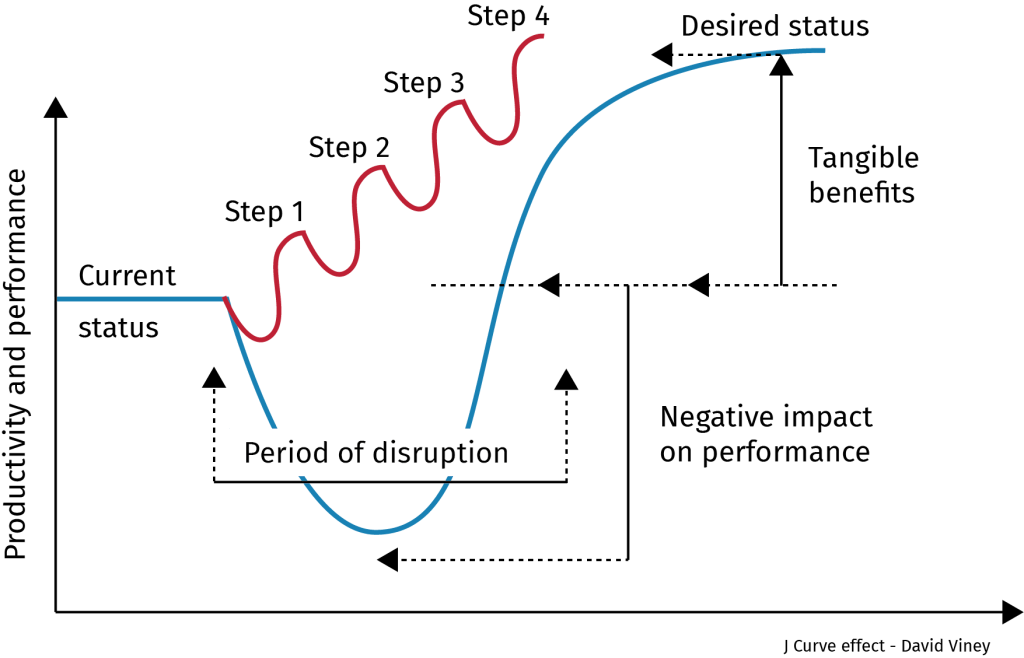The vast majority of manufacturing companies agree on one thing: overload and turbulence related to labor shortages, absenteeism, as well as difficulties in supply chains are more present than ever. In this context, companies are reluctant to start improvement projects due to the lack of capacity and time. In this article, we present an effective approach we have established to enable companies to start digital projects despite the current overload.
Why is digital transformation a must?
In a
turbulent environment, a good overview with accurate data are key factors in
improving decision making and speeding up response time. Management teams are
particularly stretched and must constantly adjust priority and solution
planning. The performance of operations management has a direct effect on the
performance of the business.
Digital
tools are therefore essential as they can significantly accelerate response
time, reduce decision making time and facilitate communications. An important
advantage to strengthen operations management with digital tools. With these
tools on hand, your managers save time, make better decisions and can manage
more complex situations. These are key elements in a turbulent environment.
How to start projects despite the overload?

Here are 3 key steps to get your digital projects off to a good start in the current environment :
1. Target the right projects = increase tangible benefits
It is essential to ensure that you identify the bottlenecks, the priority projects with high impact. At this stage, it is important to validate that the benefits of a project are compelling and urgent enough to be prioritized. Projects that facilitate operations management and reduce disruption and turbulence are good choices. Three key words to remember when targeting the right projects: it must be important, urgent and strategic.
2. Break down projects into stages = get the gains faster
At this point, consider breaking your projects into stages to generate gains at each one that is completed. In the current context, with limited resources, the best strategy to adopt is to break the project into smaller steps in order to simplify implementation, reduce risks, and be able to generate gains quickly. Each small step in the project will provide a little more room to maneuver and capacity, which will allow the next step to be implemented, and so on. For example, if you save 10 hours of management time per week in a project, these hours can be reused to execute other phases of the project. This way, we become more efficient by limiting the impact on operations. This strategy makes it easier and less intimidating for teams to integrate a new project.
3. Get support = reduce the disruption period and the negative impacts on performance
Getting support will allow you to reach your objectives faster and more efficiently. To reduce the impact on your operations, don’t hesitate to call on experts who can take over a portion of the project and avoid overloading your teams. Personalized support gives you access to additional resources, which does not affect your operational capacity. These expert resources will be able to give you the benefit of their experience, and thus save time and reduce the project implementation time because they are entirely dedicated to the project.
In conclusion, there is never an ideal context to launch a digital transformation project, whether it is an operational capacity issue or a lack of budget, there will always be challenges! That’s why it’s important to choose your new projects carefully, prioritize them and segment them into mini projects in order to make gains at each stage. Companies that succeed in integrating a continuous improvement process into their operations are always better positioned and more competitive. If you need help, don’t hesitate to call on the experts at Merkur!
ABOUT US
MERKUR is a firm of experts in manufacturing performance and innovation and has been doing so for over 25 years. From strategy to execution, its sole objective is to make Quebec manufacturing companies more efficient by offering innovative solutions in product development, operational excellence, business and supply chain strategy, manufacturing engineering, automation and smart factory. Merkur is proud to contribute to innovation and productivity in Quebec!
KHROME PRODUCT TRANSPORT is a manufacturing integrator located in Drummondville specialized in the design and manufacturing of train car interiors and exteriors. Its strength comes from its great engineering capacity and its manufacturing agility. Among its customer portfolio, there are major customers such as Alstom, Bombardier Transport and Kawasaki Rail Car.
SYNKRO is a software developed by Merkur and designed specifically for high-performance manufacturers. It collects, classifies and distributes in real time the right data to the right people at the right time. SYNKRO gives you a real vision of your operations. SYNKRO is the software solution that finally connects your plant and your offices!
